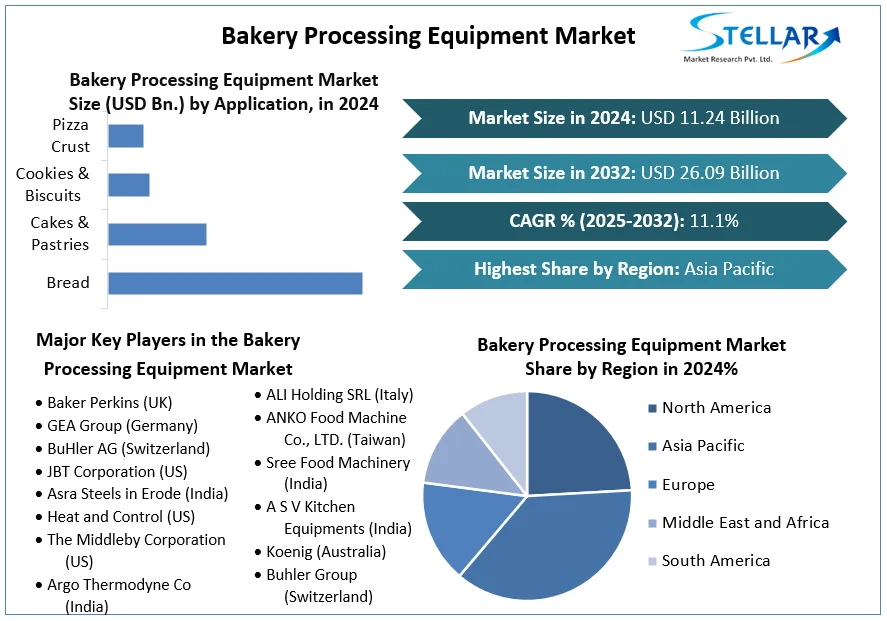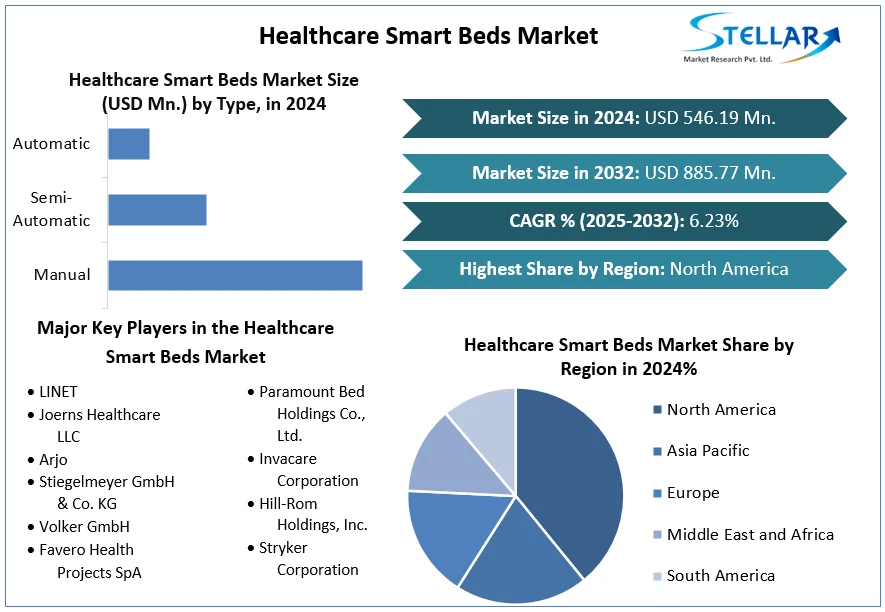Office Furniture Market Size To Grow At A CAGR Of 7.69% In The Forecast Period Of 2025-2032
Bakery Processing Equipment Market: Strategic Insights & Future Outlook
Market Estimation & Definition
The global Bakery Processing Equipment Market refers to machinery and systems used in the production of bakery products—from mixing, proofing, baking, slicing, packaging, cooling to other support equipment. This encompasses operations for bread, cakes, pastries, biscuits, cookies, frozen bakery goods, and other baked-food categories.
According to multiple sources:
One study estimated the market at USD 14.71 billion in 2023 and projected it to reach USD 25.67 billion by 2032, with a CAGR of ~6.5% over 2024-2032. Another estimated USD 14.06 billion in 2023, and forecast to USD 21.78 billion by 2030 (CAGR ~6.7%).
Yet another projection estimated a base of USD 13.42 billion in 2024 and reaching USD 21.07 billion by 2032 (CAGR ~5.8%)
These figures underscore solid growth expectations across the next decade for bakery processing machinery.
Request Free Sample Report:https://www.stellarmr.com/report/req_sample/bakery-processing-equipment-market/2479
Market Growth Drivers & Opportunity
Several major factors are driving growth in the bakery processing equipment market:
Growing Demand for Bakery & Convenience Products: Changing consumer habits—such as increased consumption of ready-to-eat baked goods, frozen bakery items and convenience snacks—are increasing production volumes and necessitating upgraded equipment.
Automation & Process Efficiency Needs: As labour costs rise and quality/consistency demands increase, bakery manufacturers are investing in automated mixers, proofers, ovens, slicers and packaging systems to reduce waste, improve throughput and maintain hygiene and safety.
Emerging Market Urbanisation & Rising Disposable Incomes: In regions such as Asia-Pacific, growing urban populations and rising spending on packaged foods are driving bakery production expansion, hence equipment demand.
Health, Specialty & Premium Trends: Demand for premium bakery products (e.g., gluten-free, whole grain, artisan styles) and industrial upgrade of lines pushes equipment makers to offer flexible, multi-function systems.
These drivers create strong opportunities for equipment manufacturers, integrators and service providers in both developed and emerging markets.
What Lies Ahead: Emerging Trends Shaping the Future
The bakery processing equipment market is likely to be shaped by several upcoming trends:
Smart & Connected Equipment: Use of IoT sensors, digital controls, predictive maintenance and real-time monitoring to optimise production will increasingly become standard.
Energy-efficient & Sustainable Machines: With sustainability goals rising, bakery factories will demand equipment that uses less energy, reduces waste, and supports clean-label and organic production.
Flexible Modular Lines: Equipment that can handle multiple product types (bread, biscuits, pastries) and rapidly adapt to new formats (vegan, gluten-free) will be in demand.
Expansion in Emerging Regions: As markets in Asia, Latin America and Africa modernise their food-processing sectors, demand for imported and local equipment will grow.
Integration of Frozen / Foodservice Trends: Growth of frozen bakery, quick-service restaurants and bakery cafes will push demand for higher throughput, automated systems and packaging capability.
For equipment manufacturers, system integrators, bakery operators and component suppliers, the opportunity lies in delivering automated, flexible, energy-efficient lines that support premium and speciality bakery formats—and doing so in growth markets such as Asia-Pacific. Industry winners will be those able to pair technology leadership with service excellence, global distribution, and agile adaptation to changing bakery formats.
In short: bakery processing equipment is not just about ovens and mixers—it is becoming the backbone of tomorrow’s bakery factories, driving higher throughput, flexibility, sustainability and quality in a rapidly evolving food-industry landscape.
About us
Phase 3,Navale IT Zone, S.No. 51/2A/2,
Office No. 202, 2nd floor,
Near, Navale Brg,Narhe,
Pune, Maharashtra 411041
sales@stellarmr.com
Bakery Processing Equipment Market: Strategic Insights & Future Outlook
Market Estimation & Definition
The global Bakery Processing Equipment Market refers to machinery and systems used in the production of bakery products—from mixing, proofing, baking, slicing, packaging, cooling to other support equipment. This encompasses operations for bread, cakes, pastries, biscuits, cookies, frozen bakery goods, and other baked-food categories.
According to multiple sources:
One study estimated the market at USD 14.71 billion in 2023 and projected it to reach USD 25.67 billion by 2032, with a CAGR of ~6.5% over 2024-2032. Another estimated USD 14.06 billion in 2023, and forecast to USD 21.78 billion by 2030 (CAGR ~6.7%).
Yet another projection estimated a base of USD 13.42 billion in 2024 and reaching USD 21.07 billion by 2032 (CAGR ~5.8%)
These figures underscore solid growth expectations across the next decade for bakery processing machinery.
Request Free Sample Report:https://www.stellarmr.com/report/req_sample/bakery-processing-equipment-market/2479
Market Growth Drivers & Opportunity
Several major factors are driving growth in the bakery processing equipment market:
Growing Demand for Bakery & Convenience Products: Changing consumer habits—such as increased consumption of ready-to-eat baked goods, frozen bakery items and convenience snacks—are increasing production volumes and necessitating upgraded equipment.
Automation & Process Efficiency Needs: As labour costs rise and quality/consistency demands increase, bakery manufacturers are investing in automated mixers, proofers, ovens, slicers and packaging systems to reduce waste, improve throughput and maintain hygiene and safety.
Emerging Market Urbanisation & Rising Disposable Incomes: In regions such as Asia-Pacific, growing urban populations and rising spending on packaged foods are driving bakery production expansion, hence equipment demand.
Health, Specialty & Premium Trends: Demand for premium bakery products (e.g., gluten-free, whole grain, artisan styles) and industrial upgrade of lines pushes equipment makers to offer flexible, multi-function systems.
These drivers create strong opportunities for equipment manufacturers, integrators and service providers in both developed and emerging markets.
What Lies Ahead: Emerging Trends Shaping the Future
The bakery processing equipment market is likely to be shaped by several upcoming trends:
Smart & Connected Equipment: Use of IoT sensors, digital controls, predictive maintenance and real-time monitoring to optimise production will increasingly become standard.
Energy-efficient & Sustainable Machines: With sustainability goals rising, bakery factories will demand equipment that uses less energy, reduces waste, and supports clean-label and organic production.
Flexible Modular Lines: Equipment that can handle multiple product types (bread, biscuits, pastries) and rapidly adapt to new formats (vegan, gluten-free) will be in demand.
Expansion in Emerging Regions: As markets in Asia, Latin America and Africa modernise their food-processing sectors, demand for imported and local equipment will grow.
Integration of Frozen / Foodservice Trends: Growth of frozen bakery, quick-service restaurants and bakery cafes will push demand for higher throughput, automated systems and packaging capability.
For equipment manufacturers, system integrators, bakery operators and component suppliers, the opportunity lies in delivering automated, flexible, energy-efficient lines that support premium and speciality bakery formats—and doing so in growth markets such as Asia-Pacific. Industry winners will be those able to pair technology leadership with service excellence, global distribution, and agile adaptation to changing bakery formats.
In short: bakery processing equipment is not just about ovens and mixers—it is becoming the backbone of tomorrow’s bakery factories, driving higher throughput, flexibility, sustainability and quality in a rapidly evolving food-industry landscape.
About us
Phase 3,Navale IT Zone, S.No. 51/2A/2,
Office No. 202, 2nd floor,
Near, Navale Brg,Narhe,
Pune, Maharashtra 411041
sales@stellarmr.com
Office Furniture Market Size To Grow At A CAGR Of 7.69% In The Forecast Period Of 2025-2032
Bakery Processing Equipment Market: Strategic Insights & Future Outlook
Market Estimation & Definition
The global Bakery Processing Equipment Market refers to machinery and systems used in the production of bakery products—from mixing, proofing, baking, slicing, packaging, cooling to other support equipment. This encompasses operations for bread, cakes, pastries, biscuits, cookies, frozen bakery goods, and other baked-food categories.
According to multiple sources:
One study estimated the market at USD 14.71 billion in 2023 and projected it to reach USD 25.67 billion by 2032, with a CAGR of ~6.5% over 2024-2032. Another estimated USD 14.06 billion in 2023, and forecast to USD 21.78 billion by 2030 (CAGR ~6.7%).
Yet another projection estimated a base of USD 13.42 billion in 2024 and reaching USD 21.07 billion by 2032 (CAGR ~5.8%)
These figures underscore solid growth expectations across the next decade for bakery processing machinery.
Request Free Sample Report:https://www.stellarmr.com/report/req_sample/bakery-processing-equipment-market/2479
Market Growth Drivers & Opportunity
Several major factors are driving growth in the bakery processing equipment market:
Growing Demand for Bakery & Convenience Products: Changing consumer habits—such as increased consumption of ready-to-eat baked goods, frozen bakery items and convenience snacks—are increasing production volumes and necessitating upgraded equipment.
Automation & Process Efficiency Needs: As labour costs rise and quality/consistency demands increase, bakery manufacturers are investing in automated mixers, proofers, ovens, slicers and packaging systems to reduce waste, improve throughput and maintain hygiene and safety.
Emerging Market Urbanisation & Rising Disposable Incomes: In regions such as Asia-Pacific, growing urban populations and rising spending on packaged foods are driving bakery production expansion, hence equipment demand.
Health, Specialty & Premium Trends: Demand for premium bakery products (e.g., gluten-free, whole grain, artisan styles) and industrial upgrade of lines pushes equipment makers to offer flexible, multi-function systems.
These drivers create strong opportunities for equipment manufacturers, integrators and service providers in both developed and emerging markets.
What Lies Ahead: Emerging Trends Shaping the Future
The bakery processing equipment market is likely to be shaped by several upcoming trends:
Smart & Connected Equipment: Use of IoT sensors, digital controls, predictive maintenance and real-time monitoring to optimise production will increasingly become standard.
Energy-efficient & Sustainable Machines: With sustainability goals rising, bakery factories will demand equipment that uses less energy, reduces waste, and supports clean-label and organic production.
Flexible Modular Lines: Equipment that can handle multiple product types (bread, biscuits, pastries) and rapidly adapt to new formats (vegan, gluten-free) will be in demand.
Expansion in Emerging Regions: As markets in Asia, Latin America and Africa modernise their food-processing sectors, demand for imported and local equipment will grow.
Integration of Frozen / Foodservice Trends: Growth of frozen bakery, quick-service restaurants and bakery cafes will push demand for higher throughput, automated systems and packaging capability.
For equipment manufacturers, system integrators, bakery operators and component suppliers, the opportunity lies in delivering automated, flexible, energy-efficient lines that support premium and speciality bakery formats—and doing so in growth markets such as Asia-Pacific. Industry winners will be those able to pair technology leadership with service excellence, global distribution, and agile adaptation to changing bakery formats.
In short: bakery processing equipment is not just about ovens and mixers—it is becoming the backbone of tomorrow’s bakery factories, driving higher throughput, flexibility, sustainability and quality in a rapidly evolving food-industry landscape.
About us
Phase 3,Navale IT Zone, S.No. 51/2A/2,
Office No. 202, 2nd floor,
Near, Navale Brg,Narhe,
Pune, Maharashtra 411041
sales@stellarmr.com
0 Comments
0 Shares
21 Views
0 Reviews












